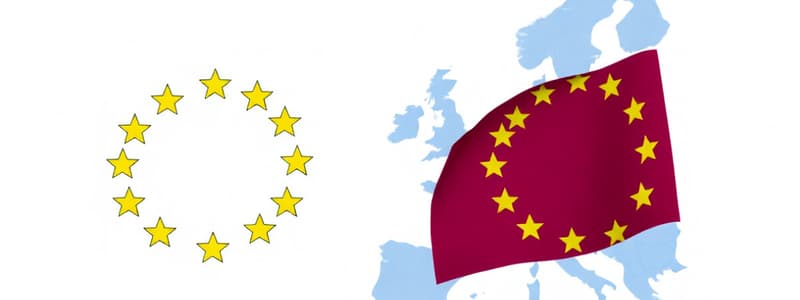Podcast
Questions and Answers
The General Council of the ECB consists exclusively of the governors of the national central banks of the 27 EU Member States.
The General Council of the ECB consists exclusively of the governors of the national central banks of the 27 EU Member States.
False (B)
The European Economic and Social Committee was established in 1992.
The European Economic and Social Committee was established in 1992.
False (B)
The European Committee of the Regions includes 329 members representing local and regional authorities from Member States.
The European Committee of the Regions includes 329 members representing local and regional authorities from Member States.
True (A)
The EU has exclusive competence in human rights matters.
The EU has exclusive competence in human rights matters.
The principle of institutional autonomy is one of the guiding principles of inter-institutional relations in the EU.
The principle of institutional autonomy is one of the guiding principles of inter-institutional relations in the EU.
The accession of the EU to the ECHR will impact the Union's competences as defined in the Treaties.
The accession of the EU to the ECHR will impact the Union's competences as defined in the Treaties.
The EU does not have the right to conclude international treaties.
The EU does not have the right to conclude international treaties.
Respect for human rights is a key criterion for the admission of new EU member states.
Respect for human rights is a key criterion for the admission of new EU member states.
The EU Charter of Fundamental Rights is not addressed to national authorities when implementing EU law.
The EU Charter of Fundamental Rights is not addressed to national authorities when implementing EU law.
General principles of EU law will no longer provide protection for human rights after the EU accedes to the ECHR.
General principles of EU law will no longer provide protection for human rights after the EU accedes to the ECHR.
The European Ombudsman is appointed according to Article 228 TFEU.
The European Ombudsman is appointed according to Article 228 TFEU.
Enhanced cooperation allows all Member States to participate equally in every decision-making process.
Enhanced cooperation allows all Member States to participate equally in every decision-making process.
The principle of presumption of competence lies with the EU, meaning that all competences are automatically conferred to it.
The principle of presumption of competence lies with the EU, meaning that all competences are automatically conferred to it.
The limits of Union competences are governed by the principle of conferral, as stated in Article 5 TFEU.
The limits of Union competences are governed by the principle of conferral, as stated in Article 5 TFEU.
If the EU decides to stop exercising its competence in a specific area, then the principle of reversibility states that the competence returns to the EU.
If the EU decides to stop exercising its competence in a specific area, then the principle of reversibility states that the competence returns to the EU.
Article 4.2 TEU states that the Union shall respect the equality of Member States before the Treaties and their national identities.
Article 4.2 TEU states that the Union shall respect the equality of Member States before the Treaties and their national identities.
According to Article 50 TEU, a Member State can unilaterally withdraw from the EU without any notification to the European Council.
According to Article 50 TEU, a Member State can unilaterally withdraw from the EU without any notification to the European Council.
The default withdrawal period for a Member State exiting the EU is one year, unless extended by unanimous agreement.
The default withdrawal period for a Member State exiting the EU is one year, unless extended by unanimous agreement.
According to Article 3 TEU, one of the goals of the EU is to establish an Economic and Monetary Union with the Euro as its currency.
According to Article 3 TEU, one of the goals of the EU is to establish an Economic and Monetary Union with the Euro as its currency.
The rights of EU membership include the power to unilaterally suspend membership obligations without any formal procedure.
The rights of EU membership include the power to unilaterally suspend membership obligations without any formal procedure.
Flashcards
Equality of Member States
Equality of Member States
This principle ensures that all member states have equal standing within the EU, respecting their unique national identities and structures, including regional and local governance.
Obligations of Membership
Obligations of Membership
Member states must abide by the obligations and rules set by the EU, including financial contributions.
Financial Obligations of Membership
Financial Obligations of Membership
Member states must contribute financially to the EU budget to support common projects and policies.
Suspension of Membership Rights
Suspension of Membership Rights
Signup and view all the flashcards
Unilateral Withdrawal from the EU
Unilateral Withdrawal from the EU
Signup and view all the flashcards
What role does the Governing Council play in the EU's monetary system?
What role does the Governing Council play in the EU's monetary system?
Signup and view all the flashcards
What is the General Council's role in the EU?
What is the General Council's role in the EU?
Signup and view all the flashcards
What does the European Economic and Social Committee represent?
What does the European Economic and Social Committee represent?
Signup and view all the flashcards
How does the European Committee of the Regions connect with the EU?
How does the European Committee of the Regions connect with the EU?
Signup and view all the flashcards
How does the EU's organizational structure differ from other international organizations?
How does the EU's organizational structure differ from other international organizations?
Signup and view all the flashcards
Legal Value of the EU Charter
Legal Value of the EU Charter
Signup and view all the flashcards
Human Rights in EU Law
Human Rights in EU Law
Signup and view all the flashcards
Sanctions for Human Rights Violations
Sanctions for Human Rights Violations
Signup and view all the flashcards
Jurisdictional Protection of Human Rights
Jurisdictional Protection of Human Rights
Signup and view all the flashcards
Applicability of the EU Charter of Fundamental Rights
Applicability of the EU Charter of Fundamental Rights
Signup and view all the flashcards
Enhanced Cooperation
Enhanced Cooperation
Signup and view all the flashcards
Principle of Conferral
Principle of Conferral
Signup and view all the flashcards
Principle of Reversibility
Principle of Reversibility
Signup and view all the flashcards
Functional Competence
Functional Competence
Signup and view all the flashcards
Accession Procedure
Accession Procedure
Signup and view all the flashcards
Study Notes
Chapter 1: European Union as an International Organization
- International Organizations (IOs) are typically based on conventional legal agreements.
- IOs are often composed of multiple states.
- IOs pursue common or collective interests.
- IOs have permanent organizational structures.
- IOs possess international legal personality.
- IOs can be categorized by their purposes (general or special), composition (universal or regional), and competences (cooperative or integrative).
Chapter 2: Treaties: Background and Historical Evolution
- Prior to the EU, the Council of Europe existed.
- Key treaties include the Treaty of Paris (1951) establishing the European Coal and Steel Community (ECSC), and the Treaties of Rome (1957) creating the European Atomic Energy Community (Euratom) and the European Economic Community (EEC).
- Subsequent treaties and developments led to significant modifications and expansions of the EU structure and scope.
- These changes include but are not limited to: the Merger Treaty (1965), the Single European Act (1986), the Maastricht Treaty (1992), the Treaty of Amsterdam (1997), the Treaty of Nice (2001), and the Treaty of Lisbon (2007).
- The development of the EU reflects gradual, progressive integration.
Chapter 3: EU Members
- Currently, there are 27 member states in the EU.
- Several countries are candidates for EU membership.
- Kosovo is a potential candidate.
- Membership criteria include stable democracies and functioning market economies, as stated in Article 49 TEU and the Copenhagen Criteria.
- The EU's enlargement has significantly increased the number of member states over time.
Chapter 4-6: Goals; Institutional System; International Legal Personality
- The EU's primary goals include promoting peace, welfare, and well-being of its citizens, establishing an internal market, promoting sustainable economic growth, and maintaining standards of environmental and social progress.
- The EU functions through various institutions.
- The institutional framework is defined in Article 13 of the TEU, aiming to promote values, advance objectives, and ensure continuity in policies.
- The EU has legal personality enabling it to enter into treaties and agreements with other entities and states.
- The EU has the ability to regulate in certain areas.
Chapter 7: Membership Status; Loss of Membership
- Article 4.2 TEU recognizes the equality of member states, their diversity, and national identities.
- Membership status involves upholding treaty obligations, including financial commitments.
- Losing membership is a process outlined in Article 50 TEU, involving notification and negotiation, and adhering to international law.
Chapter 8-10: Procedures, Functions, and Composition of EU Institutions
- EU decision-making processes involve different procedures (ordinary legislative, budgetary, consent, etc.).
- Each institution (e.g., European Parliament, European Council, European Commission) has defined functions and compositions.
- The EU's various institutions have different levels of power, and these roles can be found in EU treaties (primary legislation).
- Special Procedures involve distinct legislative processes.
- Processes for proposing new legislation and the composition of specific institutions are further detailed.
Chapter 11: EU Law and National Law & Judicial Guarantee
- The EU legal order has precedence over national legal orders within specific areas.
- Direct effect applies to treaties, regulations, and, sometimes, to directives to facilitate uniform implementation of EU laws.
- EU law is a system of legal rules developed by the EU.
Chapter 12: Principles of Subsidiarity and Proportionality
- The principle of subsidiarity ensures that EU action only occurs when it is more effective than national action.
- The principle of proportionality mandates that EU action should not exceed what is necessary to achieve its objectives.
- A priori and a posteriori controls help ensure consistency with EU principles.
Studying That Suits You
Use AI to generate personalized quizzes and flashcards to suit your learning preferences.




